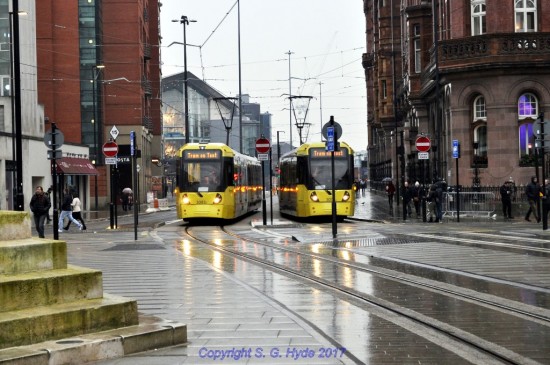Opening of Manchester Metrolink’s Second City Crossing (2CC) continues to move closer with another round of successful testing taking place over the weekend. Nine trams were out on the line on Sunday 22nd January with Cllrs Andrew Fender and Pat Karney joining the engineers to witness the rigorous testing and commissioning process.
Although no date has yet been announced – this will follow in the “coming weeks” – the increase in testing is a good sign that everything is on track for services to travel on 2CC in the early part of this year. 2CC will leave the current line at St Peter’s Square – where an enlarged stop has been built – travelling along Princess Street and Cross Street before calling at the Exchange Square stop and then rejoining the original line just before Victoria. The short section from Victoria to Exchange Square opened in December 2015.
2CC is the final piece in the jigsaw of Manchester Metrolink’s £1.5bn “big bang” expansion programme and will allow for more trams to run through the city centre whilst also allowing for more operational flexibility.
Cllr Andrew Fender, Chair of the TfGM Committee, said: “We’re on the home stretch now as engineers carry out the final phase of testing to check all the infrastructure and test out the tram management system on this important new route through the city. While the Second City Crossing is a relatively short stretch of line, it is a crucial piece in the Metrolink jigsaw – allowing us to run more trams on a more flexible and reliable tram network. That’s great news not just for the city centre, but for customers right across Greater Manchester.”
It is planned that initially services will run from East Didsbury to Shaw & Crompton via 2CC whilst in the future the Airport service may extend to Victoria. The following services will run once 2CC is open:
Altrincham to Bury
Altrincham to Etihad Campus
Bury to Piccadilly
Ashton-under-Lyne to Eccles
MediaCityUK to Piccadilly
Manchester Airport to Deansgate-Castlefield
East Didsbury to Rochdale Town Centre
East Didsbury to Shaw & Crompton

The latest day of testing was on Sunday 22nd January with nine trams in use. One of the aims of these tests was to check the interfaces with the traffic signals under various scenarios. Here the effect of presenting simultaneous signal demands from four trams was to be tested. 3083 and a double unit headed by 3005 wait alongside the Midland Hotel to cross Oxford Street whilst 2 more trams were waiting at the southbound platforms. (Photograph by Steve Hyde)
* More photos will of the testing will be included in a future update of British Trams Online.

I still feel that the junctions at each end of the Second City Crossing should have been triangular in layout, allowing much greater flexibility. Perhaps in time…………..
I’d like to see someone produce a triangular junction design for the junctions at either end of the 2CC route. Try fitting a 25 metre radius curve in at the bottom of Balloon Street or on the Princess Street Mosley Street corner without demolishing adjacent buildings.
I look forward to the enlarged Manchester network. Surely though it’s reached the point where a set of route numbers would be useful? If there are going to be as many as eight different services, it would be useful to be able to identify them easily.
Agreed. A route number or colour for the expanded network. I’m totally confused by what goes where!
Metrolink needs to be sorted. The map is so confusing with all the different routes running to different places. The map has letters but the tram destination doesnt show the letter so causes more confusion. They need a standard tram service all day. Also the Airport route needs to just be put down as one route with a note saying ‘early morning services may start/terminate at Firswood’. It would be so much easier than just loads of random routes.